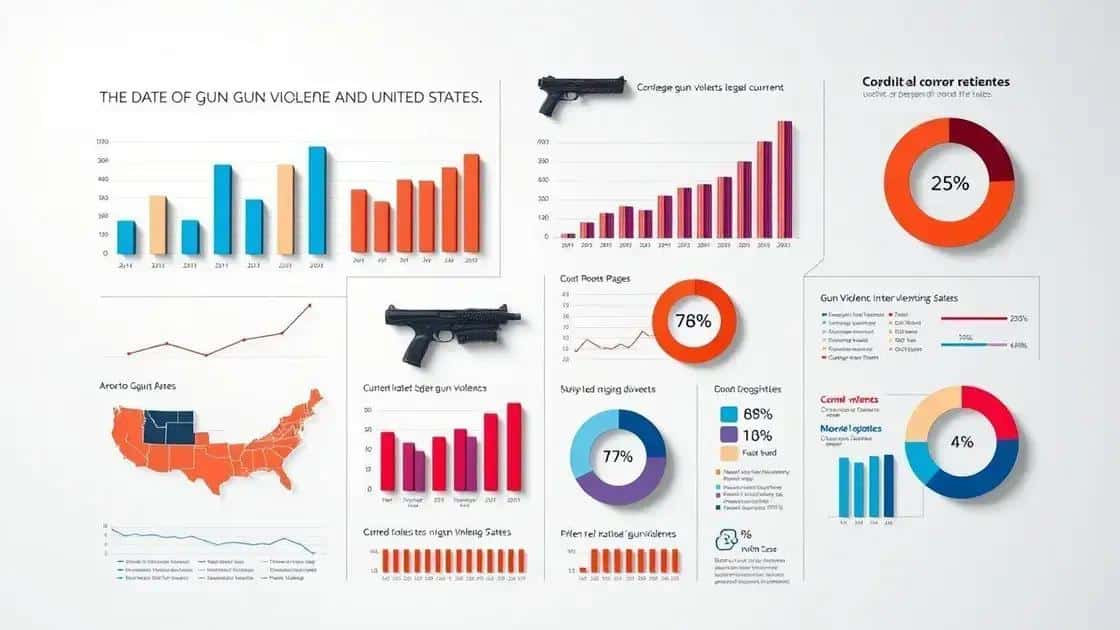Three gun control debate: understanding the arguments

The three gun control debate examines the complex issues surrounding firearm regulations, focusing on historical legislation, statistics on gun violence, diverse perspectives on gun rights, and the impact of laws on communities.
The three gun control debate brings to light the complex issues surrounding firearms, including safety, personal rights, and societal impact. What happens when rights clash with safety concerns? Let’s delve into the core arguments and explore different viewpoints.
The history of gun control in the US
The history of gun control in the US is rich and complex, shaped by numerous events and societal changes over the decades. Understanding this history is essential to grasp the current debates surrounding gun rights and regulations.
Early Legislation
Gun control laws in America have their roots in early legislation that sought to regulate firearms. The first significant law was the National Firearms Act of 1934, aimed primarily at curbing the ownership of automatic weapons due to the rise of organized crime during Prohibition. It imposed strict taxes and regulations on certain firearms.
Key Milestones
Several important milestones have defined gun control in the United States:
- The Gun Control Act of 1968 established further restrictions on gun ownership in response to assassinations and increasing crime rates.
- The Brady Handgun Violence Prevention Act of 1993 mandated background checks for gun purchases, reflecting growing concerns about safety.
- The Federal Assault Weapons Ban, enacted in 1994, targeted semi-automatic weapons but expired in 2004 and has been a topic of heated debate since.
Over the years, these laws have evolved, often in response to public sentiment following tragic events. Mass shootings have frequently reignited discussions about the need for stricter regulations. The Second Amendment remains a focal point, with proponents arguing for the right to bear arms as a fundamental liberty.
Contemporary Issues
Today, the debate continues with advocates from both sides passionately arguing their viewpoints. Supporters of gun control emphasize the need for laws that can help prevent violence, while opponents often express concerns over personal freedoms. As conversations about gun control advance, the history reflects the ongoing struggle to find a balance between rights and safety.
In conclusion, understanding the history of gun control in the US helps us appreciate the nuances of the current debate, as it blends legal, social, and emotional elements that influence public policy.
Current statistics on gun violence

Understanding current statistics on gun violence is crucial for shaping the conversation around gun control. These statistics highlight the severity of the issue and inform debates on legislation.
Overview of Gun Violence in the US
In recent years, gun violence has become a significant concern across the United States. The statistics show a troubling trend that cannot be ignored. Each year, thousands of lives are lost or impacted by gun-related incidents.
Key Statistics
Here are some key statistics regarding gun violence:
- Approximately 40,000 people die from gun-related incidents annually in the US.
- Homicides account for around 60% of these deaths, often involving handguns.
- Statistics indicate that suicide makes up nearly 50% of gun deaths, emphasizing the mental health implications.
- Mass shootings have increased, with the FBI reporting a noticeable rise in incidents involving multiple victims.
These figures not only illustrate the ongoing crisis but also indicate the various factors contributing to gun violence. Access to firearms, socioeconomic conditions, and mental health issues are all intertwined in this complex landscape.
Trends Over Time
Examining trends over time reveals patterns that are essential for understanding the issue. A substantial increase in gun violence was noted during specific periods, particularly during economic downturns and societal unrest. Additionally, research has shown that states with more relaxed gun laws often experience higher rates of gun violence.
As communities continue to grapple with the implications of these statistics, it becomes increasingly important to advocate for solutions that address the root causes of gun violence. By focusing on prevention and intervention, society can work towards reducing these numbers significantly.
Diverse perspectives on gun rights
The discussion surrounding gun rights is multifaceted. There are various perspectives that contribute to the ongoing debate, spanning legal, cultural, and social views. Understanding these diverse opinions is essential for grasping the full scope of the issue.
Legal Perspective
The legal system plays a significant role in shaping the conversation about gun rights. The Second Amendment of the US Constitution is often cited as the foundation for the right to bear arms. Legal experts debate its interpretation, leading to differing views on what restrictions, if any, should be placed on firearm ownership.
Cultural Factors
Cultural attitudes towards guns vary widely across different regions in the United States. In some areas, hunting and shooting sports are celebrated as part of local tradition. In contrast, urban centers may focus on the dangers of gun violence, leading to a push for stricter regulations. This cultural divide can significantly influence public policy and community standards regarding gun ownership.
Social Implications
Social activists and organizations have also influenced the gun rights conversation. Groups advocating for gun rights emphasize personal freedom, self-defense, and the dangers of government overreach. Opponents, however, warn against the potential for increased violence if access to guns remains unchecked. These contrasting views lead to passionate advocacy on both sides of the debate.
As the conversation continues, understanding each perspective is crucial. Individuals and communities must navigate these complexities to foster productive discussions on gun rights and potential reforms.
The impact of legislation on communities

The impact of legislation on communities regarding gun control is significant and multifaceted. Different laws can lead to varying outcomes, affecting public safety, crime rates, and community dynamics.
Changes in Crime Rates
Gun control laws often aim to reduce gun-related crimes. In some areas, stricter legislation appears to correlate with lower crime rates. For example, studies have shown that states with comprehensive background checks experience fewer gun homicides compared to those without such measures.
Public Perception and Safety
Legislation also influences how communities perceive safety. When laws are enacted to regulate firearms, many residents feel more secure, believing that these measures could prevent violence. Conversely, some individuals may feel that restrictions infringe upon their rights, leading to tension within the community.
Economic Effects
Additionally, the economic impact of gun control laws can be profound. Businesses and local economies can suffer if there is a perception of danger due to gun violence. Areas with high gun crime rates often struggle to attract investment and tourism, affecting job opportunities for residents.
On the other hand, communities that successfully implement effective gun control measures may enhance their appeal, potentially leading to growth in local businesses and improvements in quality of life.
As communities navigate the complexities of gun legislation, the effects can broadly influence social dynamics, public policies, and overall community welfare. The ongoing dialogue about these laws continues to shape the fabric of neighborhoods across the country.
FAQ – Frequently Asked Questions About Gun Control Debate
What is the main focus of the gun control debate?
The gun control debate primarily focuses on the balance between individual rights to own firearms and the community’s need for safety from gun violence.
How do gun control laws impact crime rates?
Gun control laws can significantly impact crime rates by either reducing gun violence through restrictions or raising concerns about personal safety if laws are perceived to be too strict.
What are some common perspectives on gun rights?
Common perspectives on gun rights include arguments for personal freedom and self-defense, as well as concerns about public safety and reducing violence.
Why is it important to understand statistics related to gun violence?
Understanding statistics related to gun violence is crucial for informing policy decisions and shaping community responses to firearm-related incidents.






